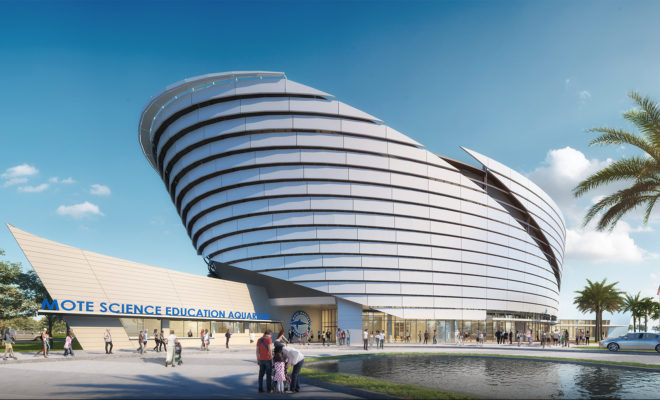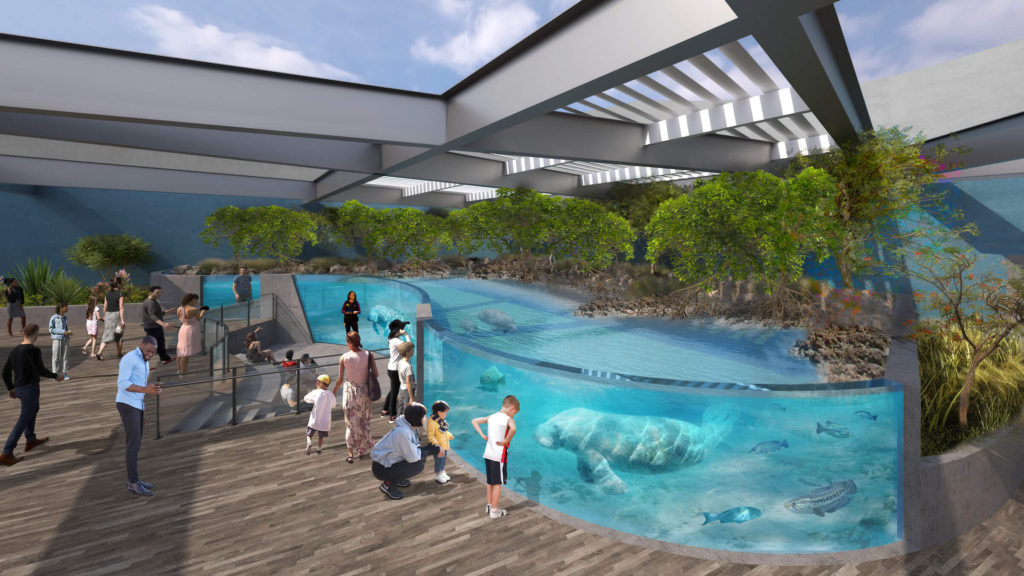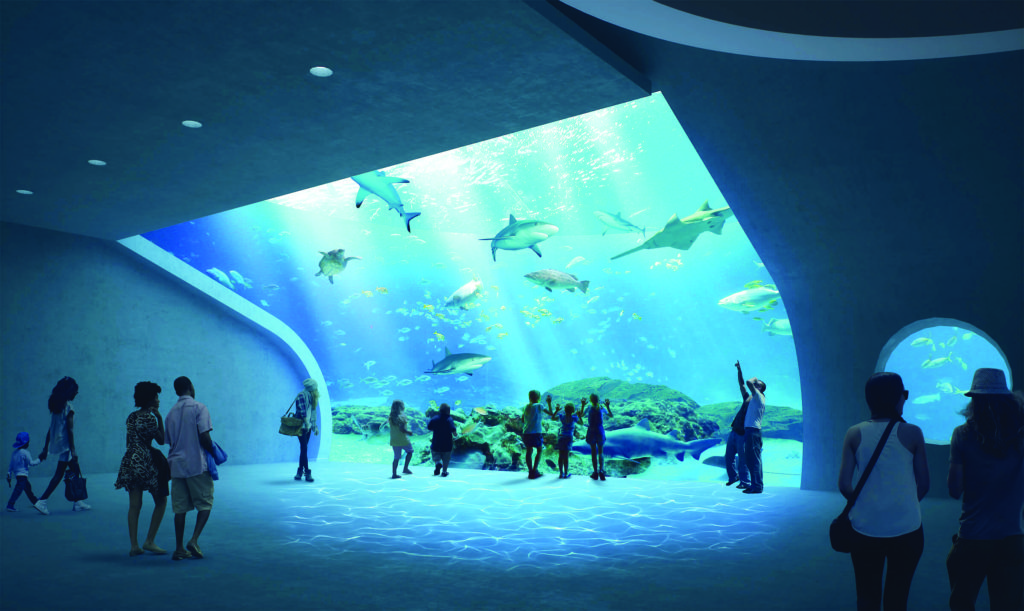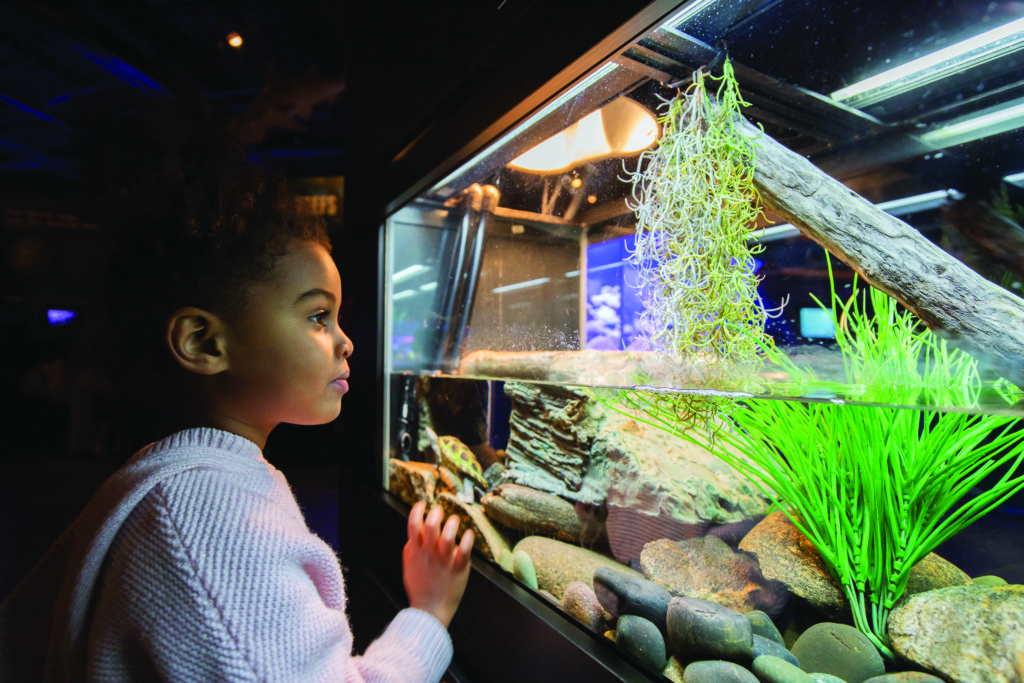
Feature
Looking Ahead to Mote SEA
By Ryan G. Van Cleave
September 1, 2020
“What’s the #1 thing people need to know about Mote?” says Michael Moore, the Campaign Director for Mote Science Education Aquarium (Mote SEA). His own answer: “That Mote SEA is happening. We’re $75 million into our $130 million goal, and we’ll be breaking ground by this October.”
The groundbreaking will mark the beginning of key site preparation to ready the twelve acres at Nathan Benderson Park for starting the construction of the actual building, which will begin in April 2021. Moore is quite confident that will happen on time, thanks to consistent, ongoing support and interest from the community that continues to bring the funding campaign closer to its goal.
Building Mote SEA is a two-year process which looks to be completed in early 2023. With a planned 110,000 square-foot hub and a million saltwater gallons of animal habitats, this is going to be an impressive aquarium that’ll compare well with the top ones in the country—Chicago’s Shedd, Baltimore’s National Aquarium, and the Georgia Aquarium. The largest animal habitat will be the Gulf of Mexico exhibit, at more than 500,000 gallons. The giant shark habitat at Mote’s current City Island campus? That’s a mere 135,000 gallons.
It’s going to be more than just an aquarium, though. Between Sarasota and Manatee Counties, we have 70,000 k-12 students who will benefit from the education programming that’ll be located at Mote SEA. “Not just field trips, either,” notes Moore, “but 3 STEM teaching labs where students can learn about all types of marine life and habitats. And since last year, our education staff has been working with curriculum administrators to prepare what we’ll be able to offer that integrates with the Florida requirement for STEM education. It’s something the school districts are quite excited about. With good reason!”

Mote’s President & CEO, Dr. Michael P. Crosby, says that the new educational offerings from Mote SEA will not only expand formal STEM education to every k-12 student in our area, but will also “transform our ability to provide informal science education and enhanced levels of ocean literacy to much larger and more diverse populations in our community.”
Here’s more good news. Mote’s not leaving City Island, where it’s been—in one form or another—since 1970. All of the space currently devoted to housing the Aquarium’s marine animal life will be changed over to accommodate a more robust research agenda. “Over the years, lots of scientists have wanted to come and be part of the research we’re doing on manatees, coral reefs, sharks, and more,” says Moore. “But we simply didn’t have the room. By moving the public animal habitats to Mote SEA, our research capacity on this campus will be greatly increased.”

And here’s even more good news. Mote’s not diving into the aquarium business blind, so to speak. They’ve been running the current aquarium in a revenue-positive manner for years, so expanding to a world-class version means they’ll be able to go from being merely revenue-positive to bringing in $3 million a year, which they plan to use to further the education efforts of Mote SEA.
The best news of all—in a very immediate, COVID-ravaged-world way—is the local economic benefits Mote SEA will provide. Initially, there’s an estimated impact of $280 million from the construction alone, but long term, the impact looks to be $28 million annually from the operations.
Moore says they expect 700,000 visitors in the first year, with 640,000 each year thereafter. “Though our space is being built to accommodate 1,000,000 people per year,” he adds. With expectations like those, Mote SEA sounds like it’s going to be both popular and one of Sarasota’s signature contemporary buildings.
One of the ways Mote SEA is going to stand out is how it uses technology. Public Relations Manager Stephannie Kettle says that when the current City Island campus brought virtual reality into the Aquarium, the results were tremendous. People loved it. “So, from the start of our planning for Mote SEA,” she explains, “we knew we wanted to incorporate high-tech engagement and learning opportunities like VR and AR.” Considering that this new aquarium complex is being constructed in such a tech-savvy age, it’ll be far easier to purpose-build things like VR and AR directly into Mote SEA’s DNA. Retrofitting tech into decades-old aquariums just doesn’t provide the same level of results.
Something many will be both shocked and excited about is their plan to allow people to…wait for it…dive into Mote SEA’s habitats. “There’s a separate back-of-house space set aside for changing rooms and equipment,” reports Moore. “And for a fee, people can sign up to dive in a half million gallons of saltwater in the Gulf of Mexico habitat and safely swim with the sharks.”
And while the majority of creatures in the Mote SEA exhibits will be connected to the research efforts of the Mote scientists, the popularity of a past traveling exhibit has convinced them to add in a special treat.
Penguins. The new aquarium will have actual penguins in an Antarctica-style habitat.
How cool—literally!—is that?

In a time when the majority of news in the daily headlines is negative, this is welcome good news. It reminds us all why Sarasota is a such a special place. While other areas are shutting down, closing off, and thinking about limitations, we’re looking to grow, expand, and be the type of community that is worthy of such a world-class institution as Mote SEA seems poised to become.
For more information on Mote Marine Laboratory or the future Mote SEA, please visit www.mote.org or call 941.388.4441.



You must be logged in to post a comment Login